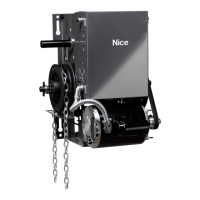. emove cotter pin tapped to pulley.
. otate clutch nut counterclockwise loosen until there is insufficient tension to permit clutch to drive door.
. radually tighten clutch nut until the tension on belleville washers is sufficient to permit clutch to drive door
smoothly but will allow clutch to slip if door is obstructed. It should be possible to stop moving door by hand if
clutch is properly adusted.
. ock clutch nut in place by inserting cotter pin into one of the
two adustment holes provided.
Caution o not over-tighten the clutch as this
will cause damage to the washers
and create adustment problems.
If your operator was ordered with an optional solenoid brake system
The brake adustment is factory set and should only reuire minor adustment after extensive use.
erify brake adustment by manually holding in solenoid plunger. hen brake is properly adusted, the brake
shoe pads should make complete contact with brake drum with sufficient brake spring tension to stop and
maintain door when solenoid is de-energied. hen solenoid is energied, brake shoes should release from
drum with sufficient clearance to avoid contact between shoes and drum.
To adust brake tension, tighten to increase or loosen to decrease nylon lock nut on brake spring bolt.
bserve solenoid during electrical testing of brake. rake spring tension must be adusted so that solenoid
should pull and release smoothly and uietly. Too much or too little tension on brake spring may cause solenoid
to burn out.
To adust individual brake shoes, loosen nut on brake shoe adustment bolt and adust bolt. hen properly
adusted, there should be a small clearance between adustment bolt and solenoid bracket when solenoid is de-
energied. hen solenoid is energied, brake shoes should move away from drum with sufficient clearance to
avoid friction between brake shoe pad and drum. After adustments are made be sure to tighten nuts on brake
shoe adustment bolts.
CTC ASTMENT
AE ASTMENT - or Models

